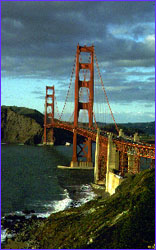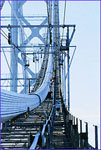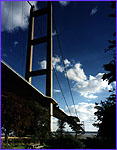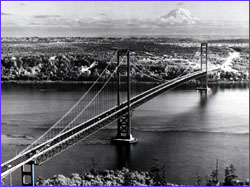 |
 |

|
Suspension Bridge
|
 Suspension bridge
Suspension bridge
Golden Gate Bridge, San Francisco, CA
|
Aesthetic, light, and strong, suspension bridges can span distances from 2,000
to 7,000 feet—far longer than any other kind of bridge. They also tend to be
the most expensive to build. True to its name, a suspension bridge suspends
the roadway from huge main cables, which extend from one end of the bridge
to the other. These cables rest on top of high towers and are secured at each
end by anchorages.
 Suspension bridge anchorage
Suspension bridge anchorage
|
|
The towers enable the main cables to be draped over long distances. Most of the
weight of the bridge is carried by the cables to the anchorages, which are
imbedded in either solid rock or massive concrete blocks. Inside the
anchorages, the cables are spread over a large area to evenly distribute the
load and to prevent the cables from breaking free.
Try It!
What are the anchorages for?
 Tie two loops of string around the tops of two hard cover books of similar
size. Tie a third piece of string to each loop so that it hangs loosely between
the books. Press down on the center string. What happens?
Tie two loops of string around the tops of two hard cover books of similar
size. Tie a third piece of string to each loop so that it hangs loosely between
the books. Press down on the center string. What happens?
 Next, stand two books about 10 inches apart. Put a stack of heavy books on one
end of string to secure it to the table. Then pass the string over each book
(letting some string hang loosely between the books). Place a second stack of
books on the other end of the string. Press again on the center of the string.
What happens? Notice how the anchorages (stacks of books) help to stabilize the
bridge.
Next, stand two books about 10 inches apart. Put a stack of heavy books on one
end of string to secure it to the table. Then pass the string over each book
(letting some string hang loosely between the books). Place a second stack of
books on the other end of the string. Press again on the center of the string.
What happens? Notice how the anchorages (stacks of books) help to stabilize the
bridge.
|
 Akashi bridge cable assembly
Akashi bridge cable assembly
|
Some of the earliest suspension bridge cables were made from twisted grass. In
the early nineteenth century, suspension bridges used iron chains for cables.
Today, the cables are made of thousands of individual steel wires bound tightly
together. Steel, which is very strong under tension, is an ideal material for
cables; a single steel wire, only 0.1 inch thick, can support over half a ton
without breaking.
 The Humber bridge
The Humber bridge
|
|
Currently, the Humber bridge in England has world's longest center span—measuring 4,624 feet. But this record won't stand for long. In 1998, the
Japanese will unveil the $7.6 billion Akashi Kaikyo Bridge, linking the islands
of Honshu and Shikoku. The bridge's center section stretches a staggering 6,527
feet. To keep the structure stable, engineers have added pendulum-like devices
on the towers to keep them from swaying and a stabilizing fin beneath the
center deck to resist typhoon-strength winds. Because suspension bridges are
light and flexible, wind is always a serious concern—as the residents of
Tacoma, Washington can surely attest.
You'll need one of the free software plugins—RealPlayer or QuickTime—
to be able to view the video clips of the Tacoma Narrows bridge. If you already have the software,
choose an appropriate connection speed (RealVideo) or the file size (QuickTime, AVI) to view
a clip.
At the time it opened for traffic in 1940, the Tacoma Narrows Bridge was the
third longest suspension bridge in the world. It was promptly nicknamed
"Galloping Gertie," due to its behavior in wind. Not only did the deck sway
sideways, but vertical undulations also appeared in quite moderate winds.
Drivers of cars reported that vehicles ahead of them would completely disappear
and reappear from view several times as they crossed the bridge. Attempts were
made to stabilize the structure with cables and hydraulic buffers, but they
were unsuccessful. On November 7, 1940, only four months after it opened, the
Tacoma Narrows Bridge collapsed in a wind of 42 mph—even though the
structure was designed to withstand winds of up to 120 mph.
 New Tacoma Narrows Bridge
New Tacoma Narrows Bridge
|
|
The failure came as a severe shock to the engineering community. Why did a
great span, more than half a mile in length and weighing tens of thousands of
tons, spring to life in a relatively light wind? And how did slow, steady, and
comparatively harmless motions suddenly become transformed into a catastrophic
force? To answer these questions engineers began applying the science of
aerodynamics to bridge designs. Technical experts still disagree on the exact
cause of the bridge's destruction, but most agree the collapse had something to
do with a complex phenomenon called resonance: the same force that can cause a
soprano's voice to shatter a glass.
Today, wind tunnel testing of bridge designs is mandatory. As for the Tacoma
Narrows bridge, reconstruction began in 1949. The new bridge is wider, has
deep stiffening trusses under the roadway and even sports a slender gap down
the middle—all to dampen the effect of the wind.
(back to intro)
(next bridge description: cable-stayed)
Photos: (1) © Mark E. Gibson/Visuals Unlimited; (2,3) Matsuo Bridge Co., Ltd.;
(4) Richmond and Rigg Photography; (5,6) Ed Elliot/The Camera Shop; (7) Corbis-Bettmann.
Build A Bridge |
Resources |
Guide |
Transcript |
Bridge Home
Editor's Picks |
Previous Sites |
Join Us/E-mail |
TV/Web Schedule
About NOVA |
Teachers |
Site Map |
Shop |
Jobs |
Search |
To print
PBS Online |
NOVA Online |
WGBH
© | Updated October 2000
|
|
|

 Next, stand two books about 10 inches apart. Put a stack of heavy books on one
end of string to secure it to the table. Then pass the string over each book
(letting some string hang loosely between the books). Place a second stack of
books on the other end of the string. Press again on the center of the string.
What happens? Notice how the anchorages (stacks of books) help to stabilize the
bridge.
Next, stand two books about 10 inches apart. Put a stack of heavy books on one
end of string to secure it to the table. Then pass the string over each book
(letting some string hang loosely between the books). Place a second stack of
books on the other end of the string. Press again on the center of the string.
What happens? Notice how the anchorages (stacks of books) help to stabilize the
bridge.





